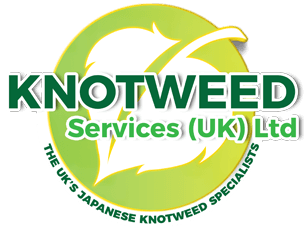
JAPANESE KNOTWEED REMOVAL SURREY
With Japanese Knotweed Technicians and Experts located all over the UK, we’re perfect for rapid, affordable Japanese knotweed removal services in and around the Surrey area.
Knotweed services UK is a member of the PCA. The PCA works with government departments, provides training and qualifications, establishes industry guidelines and works to improve outcomes across all the sectors it represents for “the damp, waterproofing, wood preservation and invasive weeds industries”. To be a member of the PCA, we’re needed to conform to rigid specifications in order to continue membership.
The application for membership is comprehensive and thorough. As a result, any member of the PCA will be relied on to provide the very best solutions for Japanese knotweed removal. We have made use of our removal capabilities to undertake many large and complicated eradication’s in and around Surrey.
For removal to be successful; professional identification, surveying and treatment along with the legitimate disposal of polluted waste has to happen. We can help.
So, Why is it a Dilemma?
Regrettably, Japanese Knotweed causes a array of difficulties for both domestic householders and commercial properties. If you are a homeowner the largest concern is that mortgage providers and banks often will not lend against a building that has an infestation. This has consequences for both buyers and sellers (find out more by reading our buyers and sellers guide to Japanese Knotweed) and if you’re wanting to re-mortgage your property. If you’re a commercial land or property owner and Japanese Knotweed is present, your project can result in being delayed for long periods of time until or whilst your infestation is being dealt with correctly and legally.
Find out more about our commercial services by clicking here.
Find out more about our residential services by clicking here.
To Summarise the Problems That Japanese Knotweed Can Cause
- It can and will cause structural damage to buildings because it WILL grow through tarmac and concrete.
- Banks MIGHT refuse to give mortgages out or loan against infected buildings.
- A plant the size of a 5 pence piece can and will grow into a HUGE plant.
- If you tread on Japanese knotweed and a piece is transported from one location to another it will grow into a new plant. No matter how poor or infertile the land is.
- The government had to spend £70 million when constructing the Olympic site for the 2012 Olympic games. Read more here.
- The UK government estimates that it may cost £2 billion to eliminate Japanese knotweed entirely from our shores!
- Hinders both visibility and use of paths, roads and other infrastructure. Producing a massive headache for commercial properties in particular.
- If left untreated – it can become very expensive to treat. The quicker you opt for our Japanese knotweed removal Surrey service – the cheaper it’s going to be
For clients in Surrey we should be your very first call. We’ll always make sure that the weed is removed in its entirety and our warranty guarantees against re-infection and colonisation. We shall also ensure that it is safely and legally transferred to a location where it may be disposed of, blocking any further spread.
Should you be trying to sell your property and your surveyor finds Japanese Knotweed on their initial report, you’re sure to run into problems. The process could possibly be delayed or terminated all together. This does not need to be the case. To be able to sell your property you may need a management plan to be in place. This plan will demonstrate that you are addressing your knotweed infestation and that it will not be a problem by the time the plan is finished.
We’ll produce a personal management plan for each customer. The plans are very detailed and are backed by our warranty meaning you can sleep easy knowing that your infestation is being eradicated.
Find out more about our Accelerant Insurance UK Limited backed warranty here.
FREE IDENTIFICATION
Fill in the form below, attach your pictures and we’ll let you know if the plant in your picture is Japanese Knotweed.
Areas we cover in Surrey
Abinger,
Addlestone,
Albury,
Alfold,
Artington,
Ash,
Ash Vale,
Ashford,
Ashtead,
Badshot Lea,
Bagshot,
Banstead,
Betchworth,
Bisley,
Bletchingley,
Bookham (Great and Little),
Box Hill,
Bramley,
Brockham,
Brookwood,
Buckland,
Burgh Heath,
Burpham,
Burstow,
Busbridge,
Byfleet,
Camberley,
Capel,
Caterham,
Chaldon,
Charlwood,
Chertsey,
Chiddingfold,
Chilworth,
Chipstead,
Chobham,
Churt,
Claygate,
Cobham,
Compton (Borough of Guildford),
Compton (Waverley),
Cranleigh,
Deepcut,
Dockenfield (part),
Dorking,
Dormansland,
Downside,
Dunsfold,
East Clandon,
East Horsley,
East Molesey,
Effingham,
Egham,
Ellen’s Green,
Elstead,
Englefield Green,
Epsom,
Esher,
Ewell,
Ewhurst,
Farnham,
Felbridge,
Felcourt,
Fetcham,
Frensham,
Frimley,
Frimley Green,
Godalming,
Godstone,
(Great) Bookham,
Guildford,
Hale,
Hambledon,
Hascombe,
Haslemere,
Headley,
Hersham,
Hinchley Wood,
Hooley,
Horne,
Horley,
Horsell,
Hydestile,
Jacobs Well,
Kingswood,
Laleham,
Leatherhead,
Leigh,
Lightwater,
Limpsfield,
Lingfield,
Little Bookham,
Littleton,
Long Ditton,
Longcross,
Lyne,
Mayford,
Merrow,
Merstham,
Mickleham,
Milford,
Molesey (East and West),
Mytchett,
Newdigate,
New Haw,
Nork,
Normandy,
North Holmwood,
Nutfield,
Oakwoodhill,
Oatlands,
Ockham,
Ockley,
Ottershaw,
Outwood,
Oxshott,
Oxted,
Peper Harrow,
Pirbright,
Pixham,
Puttenham,
Pyrford,
Redhill,
Reigate,
Ripley,
Rowledge,
Salfords,
Seale,
Send,
Shackleford,
Shalford,
Shepperton,
Shere,
South Nutfield,
Staines-upon-Thames,
Stanwell,
Stoke D’Abernon,
Stoneleigh (part),
Sunbury-on-Thames,
Sutton Green,
Tadworth,
Tandridge,
Tatsfield,
Thames Ditton,
Thorpe,
Thursley,
Tilford,
Titsey,
Tongham,
Upper Halliford,
Virginia Water,
Walton-on-Thames,
Walton-on-the-Hill,
Wanborough,
Warlingham,
West Byfleet,
West Clandon,
West Horsley,
West Molesey,
Westhumble,
West End,
Westcott,
Weybourne,
Weybridge,
Whitebushes,
Whyteleafe,
Windlesham,
Wisley,
Witley,
Woking,
Woldingham,
Wonersh,
Woodham,
Woodmansterne,
Wood Street Village,
Wormley,
Worplesdon,
Wotton,
Wrays,
Wrecclesham.
CALL US NOW TO BEGIN THE TREATMENT AND CONTROL OF YOUR INFESTATION
Knotweed Services (UK) Ltd offer our clients professional services and options, which are bespoke to individual client’s specifications and requirements.
FROM THE POINT OF INITIAL CONTACT, KNOTWEED SERVICES WILL GUIDE YOU THROUGH THE PROCESS.
RESIDENTIAL TREATMENTS.
As Infestations vary considerably from property to property it is therefore not surprising that the application technique will too. It may be necessary to use only one method of treatment or the combination of different methods.
As this is nature we are dealing with, our Japanese Knotweed specialists are trained to factor in all considerations in order to achieve optimal results. Decisions with regards to the methods of treatment opted for, will ultimately be decided by the ongoing assessment of site-specific infestations and the influencing factors/variables.
Therefore, the application procedure, giving the maximum efficacy with minimum waste and environmental impact will be tailored to specific sites.
As PCA approved Japanese Knotweed specialists, we are also guided by the latest research and development which gives guidance to the optimal time for treatment.
The latest research from Swansea University, released April 2018 by Dr. Dan Jones & Professor Dan Eastwood found that:
Applying the wrong herbicides at the wrong time of the year, leads to greater herbicide use and environmental impacts. The 4-Stage Model that we have developed links herbicide selection and application with the seasonal surface-rhizome flows in the Knotweed plant. This seasonal targeting of Knotweed delivers better results and uses lower doses of herbicide across the whole treatment life-cycle. For the public and land managers, this means more affordable treatment that is also more environmentally friendly than traditional, blanket herbicide application.
(Dr. Dan Jones – Swansea University).
Following the release of this research, Knotweed Services (UK) Ltd now operate using the 4-stage model which identifies the optimal time for treatment.
— TREATMENT OPTIONS
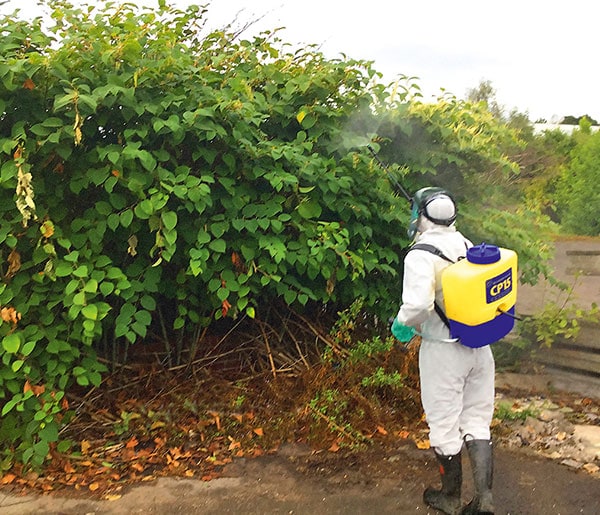
FOLIAR SPRAYING *
Most common treatment. The spraying of powerful chemicals with a knapsack. We ensure that other plants aren’t damaged. The most effective time for foliar spraying to Japanese Knotweed is in Spring

FOLIAR LEAF WIPING *
With this Japanese knotweed treatment we employ a device to ‘physically wipe’ our chemicals onto the Japanese Knotweed leaves. This application is so precise that we can often use a higher concentration of chemical.

STEM INJECTION
We apply a controlled amount of herbicide directly into the invasive weed. Due to being injected directly into the Japanese Knotweed, this is the most crafty method of removal. It isn’t dependent on the weather.
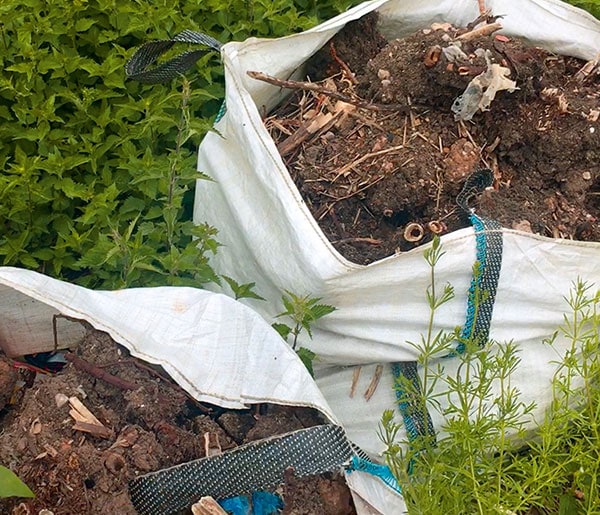
BIOMASS REDUCTION
Biomass is a form of excavation and removal but instead of extracting all of the soil impacted by Japanese Knotweed, we only remove the infested parts of the soil. It’s an excellent Japanese Knotweed control method that allows the reuse of the soil. Reducing the use of landfill.
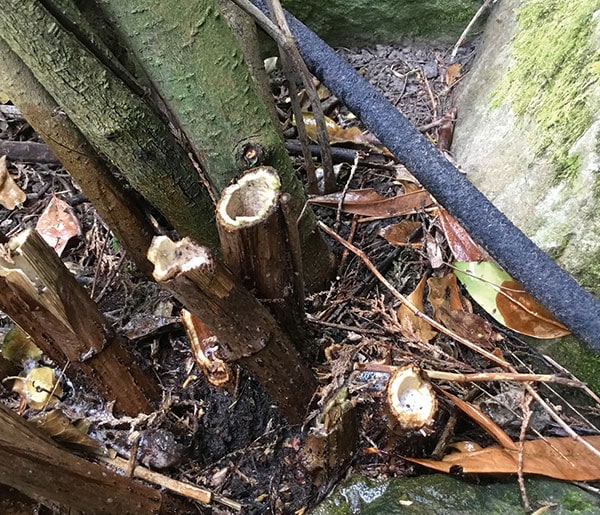
CROWN REMOVAL
Crown and stems are capable of regenerating and even small fragments of cut crown or stem are capable of regenerating and becoming a new invasive weed – removing these from the equation is a great strategy.
COMMERCIAL REMOVAL.
If you are looking to develop or build on land that has Japanese Knotweed, the option of a 5 year (herbicide) management plan is not viable. This is often down to the time constraints from planners, construction workers, resource availability & financing schedules.
In cases of development, it is also advised by the Environment Agency, that for complete eradication, the entire rhizome of the Japanese Knotweed should be removed from the soil; and this is especially so when the ground is likely to be disturbed in the construction, building of & extension of homes/industrial & commercial units & the landscaping of grounds.
Knotweed Services (UK) Ltd offer our clients professional services and options, which are bespoke to individual client’s specifications and requirements. Our friendly and helpful staff are here to talk to, offering free advice & guidance.
From the point of initial contact, Knotweed Services (UK) Ltd will guide you through the process, identifying the current use of the site, future plans for development, the time-scales and schedules in place,
identify if planning applications have been submitted or approved (where planning has been approved we will ask you to provide copies to Knotweed Services (UK) Ltd, to aid us in deciding upon the best Japanese Knotweed removal approach) & advise the most cost effective solutions available; specific to the clients project requirements.
Pictures, measurements and details specific to the site/project will be recorded – i.e. Access points for plant machinery, routes identified for disposal vehicles, potential bund areas identified & a Risk Assessment of the site and potential hazards recorded. Factors such as nearby water courses, neighbouring properties & planning for the site will also contribute to the surveyor’s final conclusions when selecting the most cost effective and appropriate management plan for the site/project.
The findings of the site survey, a schedule of works proposal and a quotation are then presented to the client in a report for the client’s consideration.
Knotweed Services (UK) Ltd will provide both the machinery and skilled staff for all of our projects. Our technicians and operatives are all trained and directly employed in-house. We will control and oversee all works directly and ensure that all legislation is strictly adhered to and that no cross contamination occurs. Alternatively, if you provide your own plant we can oversee the works for you.
NO TWO JOBS ARE EVER THE SAME.
In reality most eradication programs are a combination of treatments.
— TREATMENT OPTIONS
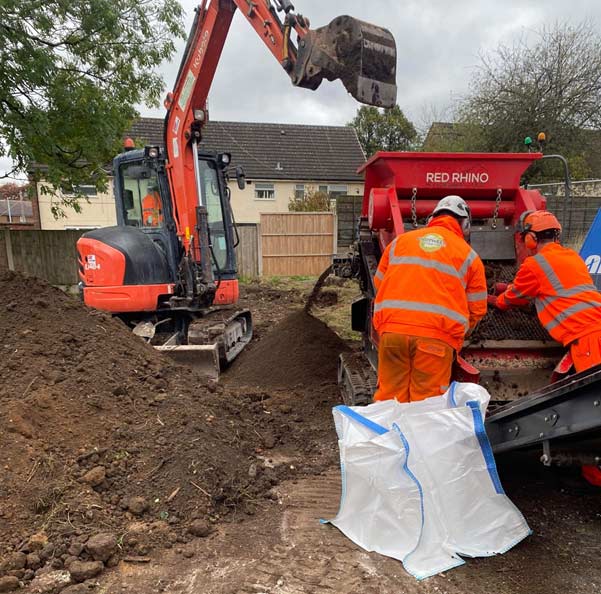
SOIL SCREENING
A tried and tested methodology used on hundreds of sites across the UK.
Using the screening method, the Japanese knotweed rhizome material is separated from the soil material. The Japanese knotweed material is then either transported to licensed landfill at a much lower disposal rate or incinerated on site using a D6 exemption from the Environment Agency or Natural Resources Wales.
The cleaned soils can then be reused in locations away from any construction, normally in soft landscaping areas.
This can reduce the landfill & backfill requirement costs significantly and can also help to reduce the carbon footprint on site due to reduced vehicle movements to landfill.

BIOSECURITY SUPERVISION
Knotweed Services can provide a biosecurity operative to supervise any excavations and movement of soils containing Japanese knotweed on site.
As part of these measures, we can provide a biosecurity boot wash and machine-washing area installed in an area at the entrance to the site.
We will provide all toolbox talks for the main contractor on site, which will be signed by all contractors involved in the operation on site.
We can provide temporary geotextile barriers if required in areas to maintain the biosecurity on site.
Once the works have been completed, we will provide the client with a full biosecurity report.
This method can be used in conjunction with other treatment methods on site.

EXCAVATION AND DISPOSAL
This treatment method is ideal where time constraints are present and there’s no other option other than to remove both the Japanese Knotweed and contaminated soil to a registered landfill.
By removing all traces of the infestation quickly, this offers a rapid solution to your problem and allows your commercial project to begin groundwork’s almost straight away. When time is of the essence, there is no quicker Japanese Knotweed removal/treatment method.
Any waste taken off-site will be done so with a licensed waste carrier to a suitably authorised landfill site.

CELL BURIAL
Cell burial comprises of moving Knotweed contaminated soil from one location on site, burying it in an excavated pit which is lined with a root barrier membrane, in a different position on the site.
The burial requirements for Japanese Knotweed are as follows:
- The Environment Agency recommends that the top of the burial cell should be a minimum of 2 metres below ground level.
- The overall depth of the burial pit should be in excess of 5 metres deep. All root barrier seams are welded together forming an encapsulated cell from which the Japanese Knotweed cannot escape. Clean soil is then used to backfill on top of the cell.
- To prevent accidental disturbance of the burial site, it is recorded on all site plans and future land owners should be made aware of the location.

STOCKPILE & TREAT
Bunding is the method of relocating contaminated Japanese Knotweed soil to a different area of the site being treated. A bund is a shallow area of the contaminated soil, typically 0.5m deep.
The bund can either be raised, on top of the ground, or placed within an excavation to make the surface flush with the surrounding area.
The purpose of the bund is to move the Japanese Knotweed to an area of the site that is not used. This ‘buys time’ for treatment that would not be possible where the Japanese Knotweed was originally located.

HERBICIDE APPLICATION
At Knotweed Services we can provide the client with bespoke treatment plans depending on the locations of the Japanese knotweed.
These plans can work in conjunction with other methods of treatment where access is limited to pedestrian movements i.e., embankments or existing pathways within a site.
This will normally consist of up to 3 visits per annum to apply herbicide by either foliar spray technique or stem injection during the growing season over a period of 3 years, with a monitoring period of 2 years thereafter.
We would select the appropriate herbicides depending on the surrounding foliage or environmental constraints.
After each visit a full treatment record would be provided with photos showing the progress of the works and then an annual report.
